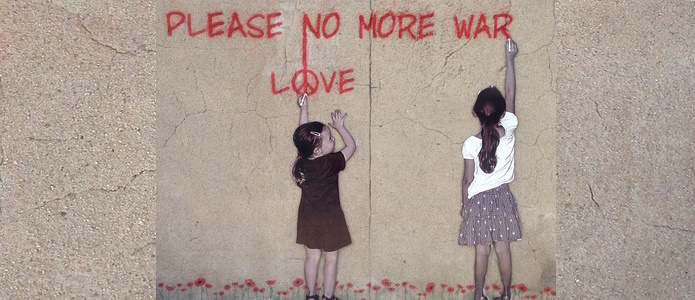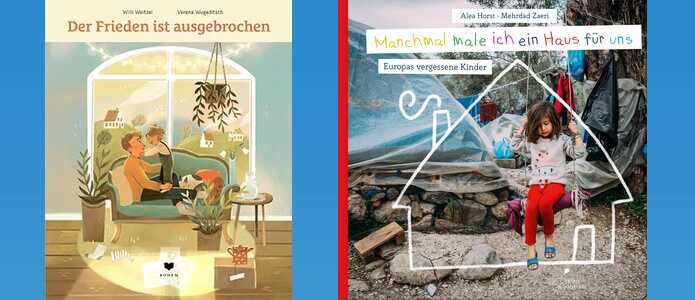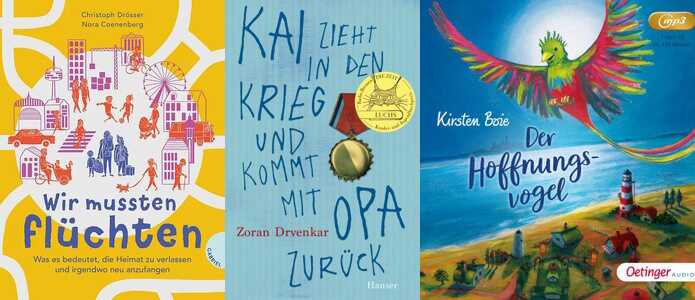Bookworld
Children’s literature in times of war

By Antje Ehman
Whenever there is war, flight, forced displacement, children are always amongst those affected, and along with their families they have to cope with profound changes. Stories in books can provide some consolation, while non-fiction books aimed at children can offer facts and explanations appropriate to their age-group. So it’s no surprise that many new books are currently appearing that deal with exactly this topic, ideally with a view to making the realities of the situation more readily comprehensible. This article features five of these books, some of them winners of major literary prizes, which are particularly compelling not only in terms of their approach, but also in terms of their physical presentation.
Picture books
Willi Weitzel set out to plead the cause of peace in a poetical manner. Following the start of Russia’s invasion of Ukraine he watched the initial TV footage in a spirit of total consternation, but then started to wonder what contribution he could make by deploying his own talents, and hit on the idea of writing a book entitled Der Frieden ist ausgebrochen (‘Peace has broken out’), which Verena Wugeditsch has illustrated with sensitivity and great expressiveness. Even the book’s title is a brilliant touch in the way that it takes an everyday expression and turns it upside down. This immediately prompts reflections on the incomprehensible course of events. In the course of a fictive dialogue a daughter asks her father a lot of questions about the issue of war and peace, and their conversation serves to illuminate the various aspects of the issue like a spotlight in the darkness. As Willi Weitzel has remarked, ‘Freedom for me means the scene at the very end of the book with its sense of complete safety and security. But freedom is dependent on a multiplicity of factors: if the circumstances are just rather than unjust, if peacefulness goes hand in hand with responsibility, love and care for others, then there is a good chance that peace will indeed break out’. In January 2023 the German Academy for Children’s and Young Adult Literature justifiably declared the book to be its ‘Book of the Month’, not least because the illustrator Verena Wugeditsch, too, is just as skilled as Weitzel at depicting frightening things like soldiers and burning houses in a restrained, unscary way.
Non-fiction books for children and young adults
Such things can’t always be captured in photographs, but Alea Horst does it very successfully. Her chosen method is to present impressive portraits of children forced to live in the Kara Pepe refugee camp on Lesbos, the third largest of the Greek islands. Manchmal male ich ein Haus für uns – Europas vergessene Kinder (‘Sometimes I draw a house for us – Europe’s forgotten children’) is a book that enables the reader to gain an insight into the lives of these children. On the left-hand pages are grouped the children’s thoughts, longings and nightmares as conveyed to Horst in countless conversations, while the right-hand pages display colour photographs that concentrate on the children, while in the background we see the surrounding countryside and ramshackle tents and containers. Mehrdad Zaeri has added numerous small black and yellow labels that deck out the houses with the things that mean most to the children. Asra and Tabasom adore their Barbie dolls, while Tajala likes painting and Alireza loves playing football. ‘When I was fifteen and a refugee child myself’, says Zaeri, ‘I also wanted desperately to have a home of my own once again together with my parents and siblings. And anyone who has experienced this profound longing will never ever forget it.’ The lot of the children depicted here also stays long in the mind, and demonstrates very clearly that children should not have to grow up in such an environment.
However, more than half of the world’s refugees are children. And Christoph Drösser and Nora Coenenberg provide primary-school-aged children with an important, comprehensive and readily comprehensible introduction to the topic in their book Wir mussten flüchten – Was es bedeutet, die Heimat zu verlassen und irgendwo neu anzufangen (‘We had to flee – What it means to leave your own country and start anew somewhere else’). In brief portraits they introduce the reader to ten children forced to flee from Ukraine, Afghanistan and Syria. As Coenenberg himself has remarked, ‘We were already looking at migration as a potential topic for our book in the autumn of 2021. But then it became emotionally very powerful when in the summer of 2022 we set about shaping the book in the light of actual events on the ground. It became very clear to me as I worked just how complex and pervasive the theme of migration is within the fabric of human history, and how important it is for us humans to support one another in such circumstances.’ We find ourselves completely persuaded all over again by this well-practised creative duo who in 2021 were awarded the German Children’s Literature Prize for non-fiction for their book 100 Kinder (‘100 children’). We know a good deal more about the topic once we have read our way through this substantial volume – not least thanks to its skilful layout, its infographics, and the specific suggestions incorporated in the chapter ‘Wie kann ich helfen?’ (‘How can I help?’).
Children’s novels and fairy tales
The impulse to help is also more or less the defining characteristic of young Kai, whose beloved but increasingly dementia-stricken grandfather is facing imminent removal to an old people’s home. As the author Zoran Drvenkar has commented: ‘I slowly came to comprehend the nature of the world inhabited by the boy and his grandfather – a world in which each wanted to help the other and in which they belonged closely together. After a while I reached the crucial insight that began to determine the shape of the whole story: all of us would do whatever it takes to save one another – from being forgotten, from losing what we value, from being engulfed by the countless lies that are also part and parcel of life.’ Drvenkar, a seasoned author, thematises the universality of war in his book Kai zieht in den Krieg und kommt mit Opa zurück (‘Kai goes off to war and returns with his Grandpa’). Grandson and grandpa set off together on an imaginary journey across time that yields profound experiences and insights for both of them. The eleven-year-old gains a completely new insight into his grandpa’s war experiences: did he in fact kill other people? How was he able to carry on living afterwards given all his painful memories? And had his grandpa really been a hero at the age of just fourteen? In war nothing makes sense anymore, and Drvenkar gets his young readers to share this realisation thanks to his virtuoso turn of language and a plethora of thoughts and images that will linger long in his readers’ minds.
The two children in Kirsten Boie’s new fairy tale Der Hoffnungsvogel (‘The hope bird’) have their own special tune, which is included on the CD that shares the same title, and on which the story is wonderfully voiced by Jona Mues. The journey that Jabu and Alva undertake here is a perilous one, though they have no weapons. For everything has changed in their previously happy country. The people there have become unfriendly and morose; there is despair on all sides. As Kirsten Boie has remarked: ‘And now it’s the same for us too because of the war in Ukraine. It’s hard to feel confident about anything at present, and many people are weighed down by the absence of any hope that things might get better any time soon.’ Many glimpses of deep human understanding are detectable between the lines of this book, and, highly experienced author that she is, Boie repeatedly offers her child readers kind guidance by addressing herself to them directly. In addition, Katrin Engelking has provided illustrations rich in both colour and atmosphere: we see heroic Helene in serious peril at sea, the robber band on the boat with its figurehead, and the magnificent spectacle of the ‘Hope Bird’ silhouetted against a full moon. ‘For me’, explains Engelking, ‘peace comes about when people coexist in a spirit of “live and let live”, while also remaining fully ready to work for the benefit of the community as a whole and seeing diversity as a strength rather than as a threat to their own existence’.
All of these five books offer much food for thought and discussion, and do so in an outstandingly artistic manner.
Antje Ehmann works as a freelance journalist, a literary-prize panelist, and an acknowledged authority within the field of children’s and young adult literature.
Translated by John Reddick
Copyright: © 2023 Litrix.de
Picture books
Willi Weitzel set out to plead the cause of peace in a poetical manner. Following the start of Russia’s invasion of Ukraine he watched the initial TV footage in a spirit of total consternation, but then started to wonder what contribution he could make by deploying his own talents, and hit on the idea of writing a book entitled Der Frieden ist ausgebrochen (‘Peace has broken out’), which Verena Wugeditsch has illustrated with sensitivity and great expressiveness. Even the book’s title is a brilliant touch in the way that it takes an everyday expression and turns it upside down. This immediately prompts reflections on the incomprehensible course of events. In the course of a fictive dialogue a daughter asks her father a lot of questions about the issue of war and peace, and their conversation serves to illuminate the various aspects of the issue like a spotlight in the darkness. As Willi Weitzel has remarked, ‘Freedom for me means the scene at the very end of the book with its sense of complete safety and security. But freedom is dependent on a multiplicity of factors: if the circumstances are just rather than unjust, if peacefulness goes hand in hand with responsibility, love and care for others, then there is a good chance that peace will indeed break out’. In January 2023 the German Academy for Children’s and Young Adult Literature justifiably declared the book to be its ‘Book of the Month’, not least because the illustrator Verena Wugeditsch, too, is just as skilled as Weitzel at depicting frightening things like soldiers and burning houses in a restrained, unscary way.

Non-fiction books for children and young adults
Such things can’t always be captured in photographs, but Alea Horst does it very successfully. Her chosen method is to present impressive portraits of children forced to live in the Kara Pepe refugee camp on Lesbos, the third largest of the Greek islands. Manchmal male ich ein Haus für uns – Europas vergessene Kinder (‘Sometimes I draw a house for us – Europe’s forgotten children’) is a book that enables the reader to gain an insight into the lives of these children. On the left-hand pages are grouped the children’s thoughts, longings and nightmares as conveyed to Horst in countless conversations, while the right-hand pages display colour photographs that concentrate on the children, while in the background we see the surrounding countryside and ramshackle tents and containers. Mehrdad Zaeri has added numerous small black and yellow labels that deck out the houses with the things that mean most to the children. Asra and Tabasom adore their Barbie dolls, while Tajala likes painting and Alireza loves playing football. ‘When I was fifteen and a refugee child myself’, says Zaeri, ‘I also wanted desperately to have a home of my own once again together with my parents and siblings. And anyone who has experienced this profound longing will never ever forget it.’ The lot of the children depicted here also stays long in the mind, and demonstrates very clearly that children should not have to grow up in such an environment.
However, more than half of the world’s refugees are children. And Christoph Drösser and Nora Coenenberg provide primary-school-aged children with an important, comprehensive and readily comprehensible introduction to the topic in their book Wir mussten flüchten – Was es bedeutet, die Heimat zu verlassen und irgendwo neu anzufangen (‘We had to flee – What it means to leave your own country and start anew somewhere else’). In brief portraits they introduce the reader to ten children forced to flee from Ukraine, Afghanistan and Syria. As Coenenberg himself has remarked, ‘We were already looking at migration as a potential topic for our book in the autumn of 2021. But then it became emotionally very powerful when in the summer of 2022 we set about shaping the book in the light of actual events on the ground. It became very clear to me as I worked just how complex and pervasive the theme of migration is within the fabric of human history, and how important it is for us humans to support one another in such circumstances.’ We find ourselves completely persuaded all over again by this well-practised creative duo who in 2021 were awarded the German Children’s Literature Prize for non-fiction for their book 100 Kinder (‘100 children’). We know a good deal more about the topic once we have read our way through this substantial volume – not least thanks to its skilful layout, its infographics, and the specific suggestions incorporated in the chapter ‘Wie kann ich helfen?’ (‘How can I help?’).

Children’s novels and fairy tales
The impulse to help is also more or less the defining characteristic of young Kai, whose beloved but increasingly dementia-stricken grandfather is facing imminent removal to an old people’s home. As the author Zoran Drvenkar has commented: ‘I slowly came to comprehend the nature of the world inhabited by the boy and his grandfather – a world in which each wanted to help the other and in which they belonged closely together. After a while I reached the crucial insight that began to determine the shape of the whole story: all of us would do whatever it takes to save one another – from being forgotten, from losing what we value, from being engulfed by the countless lies that are also part and parcel of life.’ Drvenkar, a seasoned author, thematises the universality of war in his book Kai zieht in den Krieg und kommt mit Opa zurück (‘Kai goes off to war and returns with his Grandpa’). Grandson and grandpa set off together on an imaginary journey across time that yields profound experiences and insights for both of them. The eleven-year-old gains a completely new insight into his grandpa’s war experiences: did he in fact kill other people? How was he able to carry on living afterwards given all his painful memories? And had his grandpa really been a hero at the age of just fourteen? In war nothing makes sense anymore, and Drvenkar gets his young readers to share this realisation thanks to his virtuoso turn of language and a plethora of thoughts and images that will linger long in his readers’ minds.
The two children in Kirsten Boie’s new fairy tale Der Hoffnungsvogel (‘The hope bird’) have their own special tune, which is included on the CD that shares the same title, and on which the story is wonderfully voiced by Jona Mues. The journey that Jabu and Alva undertake here is a perilous one, though they have no weapons. For everything has changed in their previously happy country. The people there have become unfriendly and morose; there is despair on all sides. As Kirsten Boie has remarked: ‘And now it’s the same for us too because of the war in Ukraine. It’s hard to feel confident about anything at present, and many people are weighed down by the absence of any hope that things might get better any time soon.’ Many glimpses of deep human understanding are detectable between the lines of this book, and, highly experienced author that she is, Boie repeatedly offers her child readers kind guidance by addressing herself to them directly. In addition, Katrin Engelking has provided illustrations rich in both colour and atmosphere: we see heroic Helene in serious peril at sea, the robber band on the boat with its figurehead, and the magnificent spectacle of the ‘Hope Bird’ silhouetted against a full moon. ‘For me’, explains Engelking, ‘peace comes about when people coexist in a spirit of “live and let live”, while also remaining fully ready to work for the benefit of the community as a whole and seeing diversity as a strength rather than as a threat to their own existence’.
All of these five books offer much food for thought and discussion, and do so in an outstandingly artistic manner.
Antje Ehmann works as a freelance journalist, a literary-prize panelist, and an acknowledged authority within the field of children’s and young adult literature.
Translated by John Reddick
Copyright: © 2023 Litrix.de